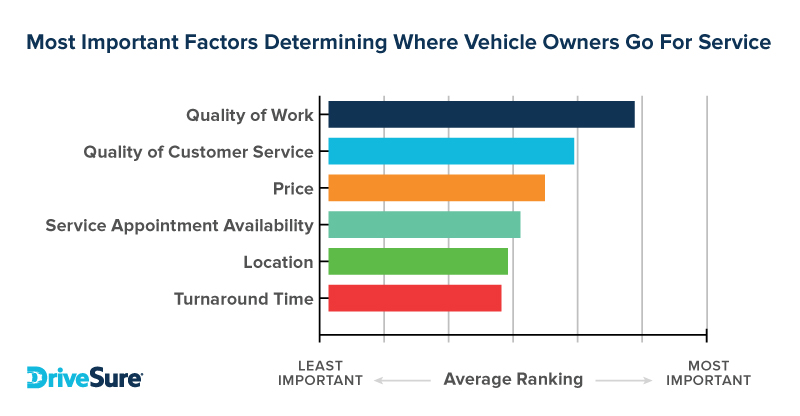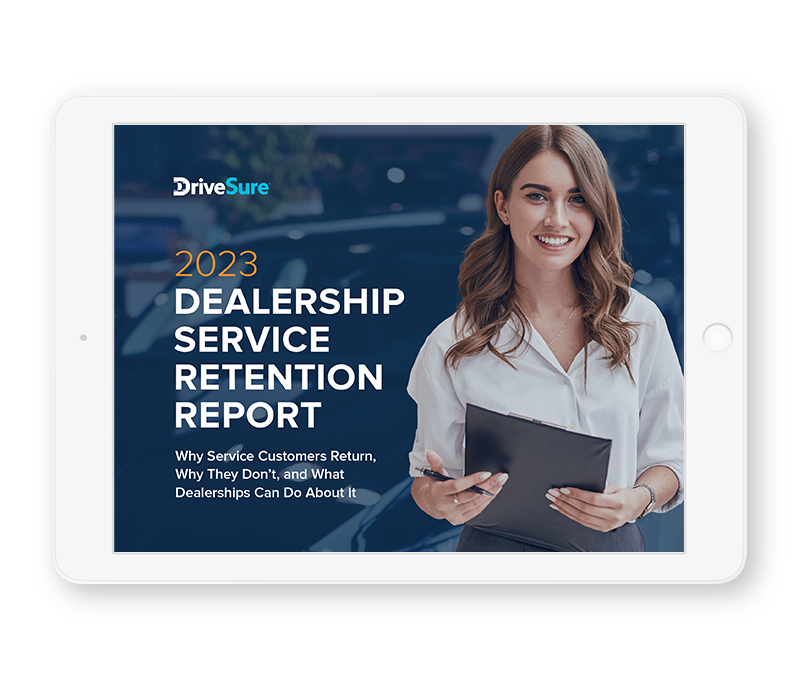In an effort to help dealerships in the competitive world of vehicle service and maintenance, DriveSure recently released the 2023 Dealership Service Retention Report. This new report uncovered a critical factor that may be affecting your customer retention: appointment availability.
We asked vehicle owners to identify all the reasons why they might go somewhere other than their dealership for service. Of all responses, 32% of consumers said “limited availability for service appointments.” The only reasons ranked higher were “a bad experience at the dealership” and a lower price elsewhere.

So what does this mean for your dealership? And what should you do about it? Let’s dive in.
Being overbooked may cost you customers
People want convenience, and this extends to scheduling vehicle service appointments. If your dealership is consistently overbooked, it might be more than just a temporary inconvenience for your customers; it could actually cost you their loyalty in the long run.
What keeps customers coming back to your dealership?
Insights from Nearly 1,500 Dealership Customers
When a customer calls or goes online to schedule an appointment and finds no available slots, the immediate reaction is often frustration. They need their vehicle serviced, and the lack of availability is a roadblock to their plans.
If a customer can’t get an appointment with you, they won’t simply wait around. More than likely, they’ll start looking for alternatives. Other service providers who can accommodate their schedule suddenly become attractive options.
Once a customer decides to try a competitor due to appointment unavailability at your dealership, they might discover other appealing aspects of that service provider. Whether it’s a warm welcome, efficient service, or a comfortable waiting area, these positive experiences might make them consider switching permanently.
The short-term loss of a service appointment might seem minor, but if it leads to a customer discovering a competitor they like, you have the long-term impact on your business to consider. Losing a customer means losing not only a single service appointment but potentially all future business from that individual.
Loyal customers aren’t immune to frustration
You might think that your most loyal customers would be understanding and patient, but the report shows loyalty doesn’t have a big impact here, even for your best customers.
On the upside, customers who identified as “extremely loyal” to their dealership were 5% more likely to wait than the overall average (meaning just 27% said that lack of appointment availability would cause them to go elsewhere).
However, for every other segment, the percentage is substantially higher: even for customers who identify as “mostly loyal,” a full 37% of them would go elsewhere for service if they couldn’t find an appointment. The “somewhat loyal” (37%) and “not loyal” (57%) segments weren’t promising either.
Customer loyalty is far from unconditional, and even your best customers value their time and convenience quite highly.
Online scheduling isn’t a perfect solution
With 44 percent of vehicle owners naming online scheduling as their preferred booking method, the ease of booking appointments online is vital. However, when customers schedule online and leave your website without booking due to unavailability, you lose the opportunity to understand their frustration or offer alternative solutions.
Technologies like booking abandonment can help ensure that customers who leave your website without booking are followed up with. Booking abandonment tools are designed to identify and re-engage customers who have initiated but not completed a booking process, such as scheduling a service appointment.
The tools monitor users’ actions on the booking platform, identifying when a user starts but doesn’t finish the booking process. They gather information about the user, such as contact details and the service the customer was interested in — without breaching privacy regulations.
From here, dealerships can follow up with an automated email or text message shortly after the booking abandonment, reminding them that they haven’t finished booking, and even offering assistance. Depending on their reason for the incomplete booking, this can be an opportunity to offer an alternative booking method, or giving them an incentive to book now.
Get customers to book the next appointment while they’re still at the dealership
About 10 percent of survey respondents prefer to book their next appointment while still at the dealership for their current appointment (only 3% prefer calling in to book). This preference alone indicates that offering advance booking could alleviate some of the concerns about appointment availability.
However, this strategy has an additional advantage. By engaging customers on-site, offering personalized scheduling options, and incentivizing advance booking, dealerships can distribute appointments more evenly and reduce peak demand.
In other words, this even distribution of appointments ensures that slots are consistently available, minimizing the risk of customers seeking services elsewhere due to lack of availability.
By aligning the booking process with customer preferences and vehicle maintenance schedules, you can create a more personalized experience that not only meets immediate customer needs but also helps build long-term relationships, showing you’re proactive about making sure each customer’s car is taken care of.
That said, you’re not stuck managing a fixed number of your appointment slots — you can usually find ways to accept more customers by expanding capacity.
Expand service lane capacity to avoid overbooking
Expanding your service lane capacity allows you to service more vehicles simultaneously and efficiently manage peak times. With more available appointments, customers have an easier time getting into the shop, and so are more likely to keep coming back.
Thankfully, expanding service lane capacity doesn’t necessarily require a significant investment or structural expansion. You can make small adjustments to quickly expand your service lane’s output, like having more active technicians during peak hours, setting up a streamlined check-in process, and assigning tasks according to the technician’s expertise (in other words, don’t put your experienced technicians on jobs a newbie could handle).
To read these tips in more detail, we previously wrote about how to expand service lane capacity.
What keeps customers coming back to your dealership?
Download the 2023 Dealership Service Retention Report to see what dealership service customers have to say.


